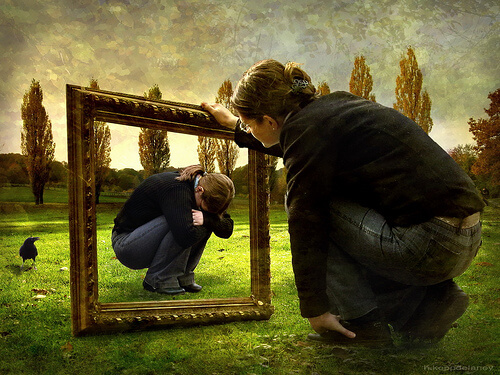Make Peace with Yourself Today

I want to make peace with myself. After all, I’ve done myself so much harm and I have let myself be led by so many confusing messages, that I have turned into my own worst enemy.
Just by going out, we’re bombarded with a whole bunch of messages, advertisements, and posters, that tell us to be thinner, to hide our wrinkles, to have fuller hair…What happens if we have a few extra pounds, deep wrinkles, and thin hair? Will we feel bad, or sad because of it? Will we feel sorry for ourselves?
However, while that’s the reality we see at first, it’s up to us to decide if it’s true or not. We simply have to look at other cultures to see if they have other standards of beauty. Why do we stubbornly continue giving power to something that will change in time, and that, in reality, is unreal and difficult to achieve?
The Hole of Perfection

We can consider the search for perfection that society imposes upon us within reach, but in reality, it’s just like a hole we keep falling deeper into. There is no end, nor is there a way out, because we are bombarded with messages from all sides about weight, stature, beauty, that we give too much credibility to.
We move between pretty and ugly, the good and the bad. There seems to be no middle ground, it is all or nothing. Possibly, we might wake up happy in the morning. Happy with the person we see in the mirror. But what we see when we leave the house, the criticisms, the rejections, causes us sadness and frustration.
Read also: Self-Esteem: The Key to Happiness
We tend to look for everyone else’s approval, to fit in so that the rest of society will accept us. However, even though what is unique and different may have visibility, it’s important to learn not to compare ourselves to others.
- We cannot pretend to have thin legs if, in reality, our legs are much bigger. Rejecting the truth can create a cycle of distress that will not have a good outcome.
- Do not pretend to be what we are not. Do not view society’s standards of what is beautiful as true. In reality, these standards have changed significantly over time.
- We simply have to look at the past and how people were in that era, what their idea of beauty was, to see that this is true.
You might also like: I Don’t Like My Body, But I Accept It
Making peace is possible

It’s possible to make peace with yourself. Stop blaming yourself. Start seeing yourself as one of a kind, unique, and full of good things. Isn’t it true that the person who does not mind being who they are captures our attention? Being one of a kind makes them stand out. And they don’t care about being rejected. Their uniqueness attracts worthy people.
Comparing ourselves to others is brutal to our self-esteem, which will believe that we are not enough, equal, valuable…It is a free way to harm ourselves and not be happy. Furthermore, we deserve to enjoy life without allowing ourselves to hurt from these, merely aesthetic, questions.
Making peace with ourselves does not just have to do with the superficial, but also with all the beliefs that surround us, and many of which have embedded themselves deeply in our minds.
For example, the tendency of not being able to say “no” just because we want to be nice to everyone or because we feel that love means we have to suffer wrongs. Falsehoods plunge us into harmful relationships.
They make us live through situations in which we do not feel comfortable. But, society taught us that, and what we give a great amount of credibility.

In conclusion
We should learn to question everything and open our eyes to the true reality. And, more importantly, we should stop blindly accepting what others want to idealize and exhibit. It’s possible to make peace with our true selves. Undo everything that we thought was true, and made our life so difficult.
It is time to free ourselves from that great weight, to stop blaming ourselves, to stop wanting to be like someone else. The time is now to concern ourselves with making us shine.
Feature image courtesy of @wikiHow.com
All cited sources were thoroughly reviewed by our team to ensure their quality, reliability, currency, and validity. The bibliography of this article was considered reliable and of academic or scientific accuracy.
- Branden, N. (1995). Los seis pilares de la autoestima. Barcelona: Paidós.
- Ferreras, E. (2007). La autoestima. Anales de Mecánica y Electricidad, 54–60.
- Branden, N. (1989). Cómo mejorar su autoestima. Círculo de Lectores., 1–64. https://doi.org/10.1186/cc1474
- San Martín, J. L., & Barra, E. (2013). Autoestima, apoyo social y satisfacción vital en adolescentes. Terapia Psicologica, 31(3), 287–291. https://doi.org/10.4067/S0718-48082013000300003
- Antonio, P. J. (2000). Yo, Autoestima , Autoconcepto. Plan de Acción Tutorial: Gabes, 1, 288.
This text is provided for informational purposes only and does not replace consultation with a professional. If in doubt, consult your specialist.








